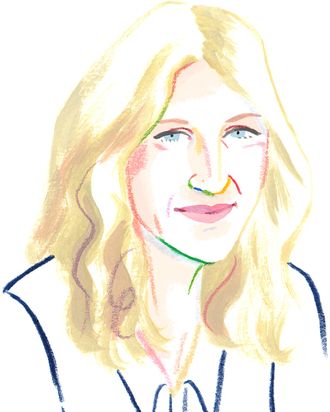
Jessica Banks is the founder of RockPaperRobot, an engineering and design firm that developed the so-called “float table,” a table made of cubes that appears to levitate. She lives alone down the street from her office at New Lab in Brooklyn and has a dog who lives in Wisconsin. She manages a team of four people and uses an intricate system of scents to signal when she needs to shift between tasks. Here’s how she gets it all done.
On her color-and-shape-based to-do lists and how she “hypertasks”:
I have a kind of dyslexia, so I use colors and shapes to help me stay organized. My Google Calendar system is pretty sophisticated even though it looks like a unicorn barfed in my browser. I use the “All Day Event” option and multiple calendars for tasks. For instance, things that I work on with Pete, our head of fabrication, are purple because Pete and purple start with P. The green calendar is for money-related tasks like client invoicing, vendor payments, equity assignments. I use white for my own personal to-dos (like helping my dad set up his Etsy account or buying plant food). It’s white so it’s not too visually intrusive and can be de-prioritized. Red is super important business-related stuff. Can’t ignore the red. My favorite color is gray, so my business tasks are in a gray calendar. I’m more productive on rainy, gray days too, so there is some other relevance to the color code. When I finish something, I move the entry to the day before so I can track my accomplishments. For bigger ongoing projects, I just keep moving things into the future since they often have outside dependencies I need to wait on. Sometimes I squint and cross my eyes to look at the screen kind of blurry so I can get a visual feel for how my week is stacked.
I do what I call hypertasking, not multitasking: I cycle through my ongoing projects over and over really quickly, hitting each one many times in a day. So instead of doing tons of things in parallel (if that’s even possible), I loop through them serially at hyperspeed. This may only be a semantic differentiation, though the other day I walked out of the house with one boot on because I had to jump on a conference call when I was dressing, which I guess could be interpreted as a parsing error.
On checking in with her staff without too many meetings:
Our team sit-downs are not super serious: Is anything breaking? Is anyone hurt? I don’t like to do a lot of group meetings because I think they’re often a waste of time. In any given meeting, it’s pretty safe to say that half the people are having their time wasted by half the other people. I guess this means that a four-person meeting should probably just be an email. Of course, sometimes we have an all-hands-on-deck situation that does require more mass — like when we are stuck on a problem and need outside perspectives and skill sets to shake it up.
I try to condense my own meetings and calls into the morning so I can have afternoons free from interruptions. I can’t tell if I’m a morning person or a night person anymore — or really an any time of day kind of person — though I tend to get a lot of work done very late at night simply because I’m alone and in my jammies.
On comparing her ideal self to her real self:
I have these two versions of myself that exist in parallel: the ideal me and the real me. I try to steer myself toward my asymptotic ideal. Ideal Jess wakes up at 6 a.m. without any laptops or spoons in her bed (Real Jess loves snacking on peanut butter) and is five-eight (real me is five-four). First she works out, preferably boxing, followed by some Zen-y activity like meditation or lock picking. Then she makes a kale smoothie and walks to work with birds flitting around her. She’s laser-focused and naturally backlit. A solid leader too, helping solve problems with just the right hints so people feel empowered. She does bonding activities with her team: “Let’s go get a drink at 5:30,” she says at least once a week. (Actually, I’m retracting that team bonding because being Ideal Jess means I can make it to a calligraphy class in the city by 6:15. Plus, it’s better to have people just leave work and live their own lives.) At night, Ideal Jess goes dancing or installs a new showerhead in her bathroom or works on her book of short stories and then goes to sleep around 1 a.m. without playing Fruit Ninja or reading about Trump in bed. Ideal Jess doesn’t even have Fruit Ninja on her phone. And she always sleeps on her back to prevent wrinkles. Then she wakes up at 6 a.m. again and is still five-eight.
The real me, however, snoozes like a motherfucker. I intentionally don’t configure my alarm to allow for snooze but somehow, even in that not-totally-conscious post-alarm state, I find a snooze loophole … a snoophole! It could be some groggy justification about wanting to save water so I should skip my shower to sleep more, or rationalizing that I’m really planning my outfit while lying there. Sometimes I actually construct physical snooze contraptions like balancing the phone right on the edge of my bed near my hand so if I move, it’ll fall and wake me.
I also know that I go from bed to desk in 12 minutes because I live very close to my office. Every night, I, Real Jess, set my alarm for 6 a.m. with the hope that I’ll act like Ideal Jess when it goes off. I like that feeling … going to bed with hope. One’s days should always end in hope.

On switching up her schedule to increase productivity:
I’ve been reading some stuff on productivity that says that my particular schedule (work and meetings in the morning and then have free creative time later in the day) should be switched. Even though I might feel like I’m getting more done at night, it’s possible that is actually a delusion! We’re going to try some different productivity methods at the office, so next week we’ll backload my days and see how my mornings go. Maybe I’ll spend some of my morning time figuring out how to quantify my productivity so the experiment is actually a worthwhile endeavor.
On knowing when to ask for help:
I’m very resourceful. I’m good at finding people who will very quickly get me to an answer and I’m unabashed about asking for help. There are times when I realize I’m on a track that will quickly lead well beyond my scope of knowledge, so I need to search for an expert in an often pretty esoteric topic, like dwell mechanisms or ergonomic micro-movements. I find people are usually thrilled to be asked for advice. I love when people ask me for help as long as it doesn’t involve writing emails.
On how she uses dozens of scents to trigger her mind to change tasks:
I tackle so many different types of tasks during the day, from sales projections to engineering a new magical locking system to negotiating worker’s-comp regulations to discussing machine tolerances with vendors. I use different scents from Demeter to help me get into different headspaces. The more earthy ones, like beetroot, dirt, and tomato, are for when I have to be more grounded and logical. I often use those when I am doing computer-assisted design work. I’ll spritz the sweeter scents (devil’s-food cake, vanilla ice cream, Junior Mints) when I need to think about really overarching pie-in-the-sky things like marketing campaigns. When I’m stuck on a problem and really have to create more fluid thoughts, I go for the watery smells. They’re admittedly a little arbitrary but storm, steam room, or holy water can help me out of a rut. Something like fiery curry has more of a spicy note — I find it works well when I have to focus on logistical business crap.
I started doing this smell switching when I was at MIT in grad school. At first I was just trying to involve another sense to help me learn — the more senses you involve in an experience, the more indelible the experience becomes. And smell is one of the most powerful memory inducers. It didn’t take long for me to realize that the scents could trigger different mental states, so I started to really play around with what works for me. I have 160 different scents … Well, 159. I ran out of waffles (it smelled like maple syrup) really quickly, and I didn’t buy it again because I felt like I was oddly addicted to it.
On the pathology of ambition and knowing when you’re a success:
I can’t believe anyone really knows what it means to start a company the first time they do it. It must be similar to having a baby. I mean, we all see babies and businesses in the world, but raising one involves both blind faith and some evolutionary or psychological imperative. I had (and still have) to assume that I will be successful, or else I would have packed up my things years ago. And that doesn’t mean I necessarily know what success looks like. It just means that I believe I will recognize it when I see it.
It also means I might be sick: I kind of think that ambition is a pathology and it’s contagious in New York. Maybe stress is even a symptom of ambition. My stress comes from feeling tremendous responsibility for the people I work with: making sure that they’re happy, fulfilled, and paid.
On eschewing balance:
I don’t think I have this work-life balance everyone talks about. Though I am not sure our balances would ever look the same anyway. Balance is relative to the system; it depends where you set your extremes. Like sometimes I sleep at the office. Yes, I have a 12-minute walk home, but sometimes I still sleep at New Lab on a sheet of packing foam. It doesn’t get totally dark in our studio, either, because the safety lights in the main building never go off. So I actually have to build a fort out of chairs and tambour backing material. Office camping at 3 a.m. feels about as far from Real Jess as it does from Ideal Jess. Doesn’t that count as balance?




